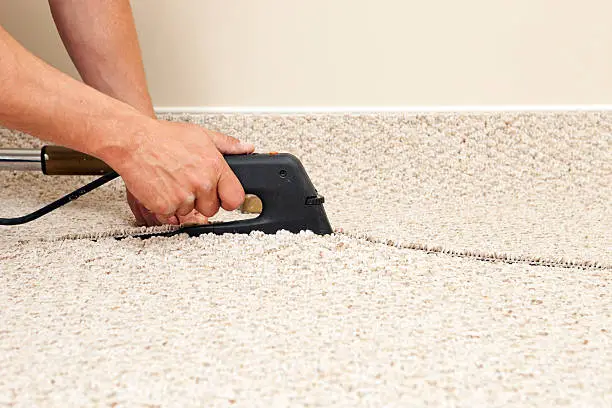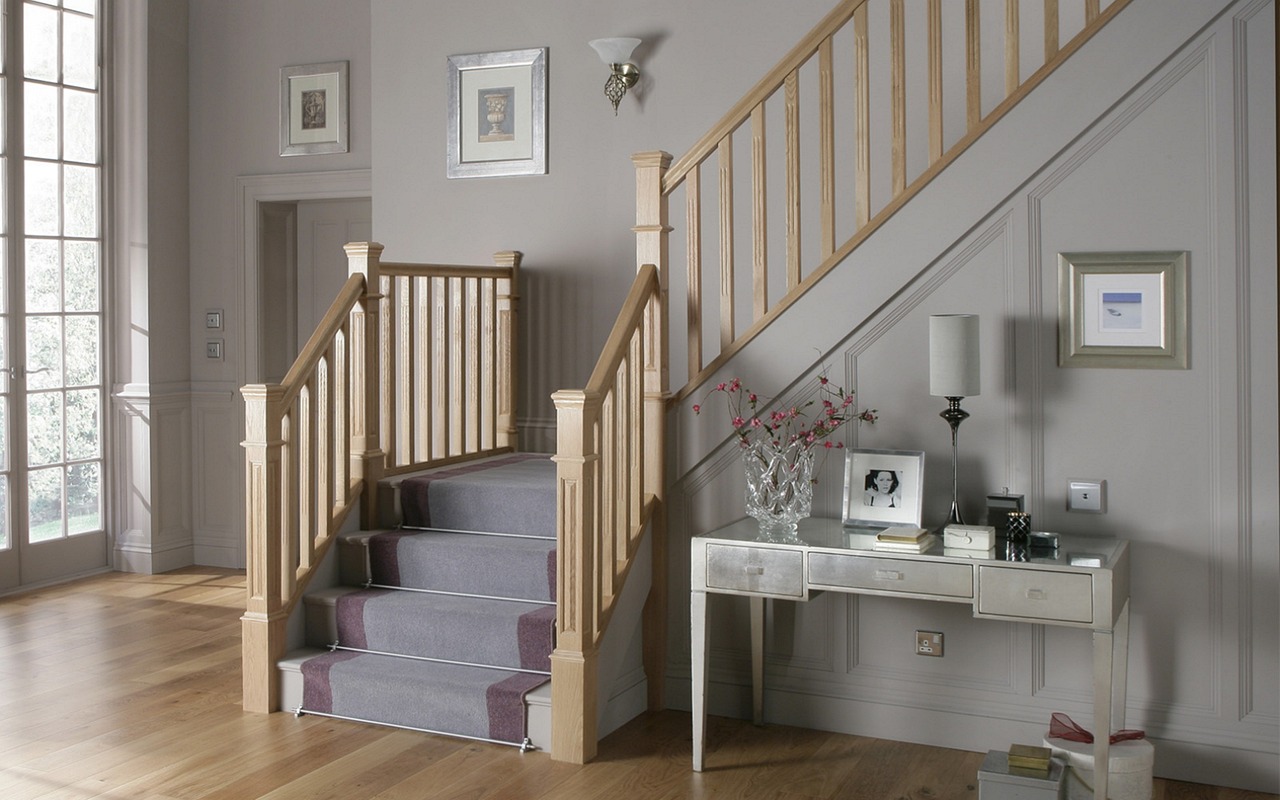Installing carpeting on stairs with a landing can be a challenging and time-consuming task. However, when done properly, it can add an elegant touch to the home decor.
Installing carpet runners on stairs with a landing requires several steps and tools, but following these instructions will make the process easier and result in an attractive end product.
This guide explains how to measure your carpet runner, cut it to fit, secure the edges of the carpet, and attach tack strips at each step. With some patience and care, you too can install beautiful stair runners that will last for years!
Clean the Stairs and Landings before Installation
Before doing anything, it’s important to clean out any dirt or debris from the stairs and landing. Vacuum the steps thoroughly and use a broom to sweep away any dust or dirt that may have accumulated in corners or other hard-to-reach areas.
Cleaning before installation will ensure that your carpet runner will stay secure and look great for years to come.
Tools Required

Installing carpet runners on stairs with a landing requires a few key tools. A measuring tape, utility knife, knee kicker (a tool used to stretch the carpet over the edges of each step), and a hammer are all necessary for this project.
Additionally, you’ll need some tack strips and adhesive to secure the edges of your runner in place.
Measuring and Cutting the Carpet Runner

The first step in installing carpet runners on stairs with a landing is to accurately measure the area and cut the carpet runner to size. Start by measuring from the bottom of the staircase to the top, taking into account any turns along the way.
If there are two landings at different levels, make sure to measure separately for each one. When you have your measurements, it’s time to mark and cut your carpet runner.
Lay out the runner on a flat surface and use a tape measure or yardstick to mark off sections according to your measurements. Use scissors or a sharp utility knife to carefully cut along these lines until you have your perfect-sized stairway rug!
Securing the Edges of the Carpet
Once you have your runner cut to size, it’s time to secure the edges. Start by applying double-sided carpet tape all along the edges of the rug. This will help keep it securely in place on your stairs and prevent it from slipping or bunching up.
Once that is done, use a carpet roller (or heavy object) to press down firmly along each edge and make sure that the adhesive is making full contact with the runner.
Attaching Tack Strips
The final step in installing stair runners with a landing is attaching tack strips around each step. Using a hammer, attach metal tack strips at least one inch away from each side of each stair tread and riser.
Make sure that the strips are flush with the stair edges so that the carpet can lay flat over them without any bumps. Once all of your tack strips are in place, you’re ready to attach your runner!
Laying Down and Securing the Runner
Now it’s time to lay down the carpet runner on your stairs. Start at the top of each step and carefully stretch down into place, making sure there is an even amount of fabric on either side.
When it reaches the bottom of each tread, tuck in both sides underneath the riser using a putty knife or other flat object. Finally, use a staple gun to secure each edge along each tread and riser beneath one inch from its edge.
Repeat this process until you have secured the runner in place on all of your stairs.
Types Of Carpet Runners
1. Velvet Carpet Runner
Velvet carpet runners are the perfect way to add luxury and sophistication to your décor. Soft and plush velvet can be found in many colors so you can find one that matches your existing color palette.
This type of runner is ideal for bedrooms, hallways, and other low-traffic areas where you want an extra touch of comfort.
2. Sisal Carpet Runner
Sisal carpeting has become increasingly popular due to its durability and natural look. It’s perfect for any room that has a lot of foot traffic, as it can handle the wear and tear.
Sisal carpeting is available in a variety of colors and styles, so you can find one that fits your décor perfectly.
3. Berber Carpet Runner
Berber carpet runners are ideal for busy homes as they’re made of durable fibers that can hold up to heavy foot traffic. This type of runner comes in many colors and textures, making it easy to choose the perfect one for your space.
4. Jute Carpet Runner
Jute carpet runners have a natural look that makes them great for adding texture and warmth to any room. They come in various shades of brown, but you can also find jute runners in vibrant colors. This type of runner is best suited for low-traffic areas as it can stain easily.
5. Flatweave Carpet Runner
Flatweave carpets are a classic choice that never goes out of style. Not only do they look great, but they’re also incredibly durable and easy to clean. Flatweave carpeting comes in various textures and patterns, so you can find one that fits your décor perfectly.
Types Of Stairs
1. Straight Staircase
These are the most basic type of staircases. As the name suggests they go straight up and down, typically constructed in either timber or metal.
They’re well-suited for homes with limited space due to their simple design, but can also be used to make a grand statement when going from one level to another. In addition, they’re often seen as an affordable option if you need to stick to a budget.
2. Curved Staircase
These are staircases that have a curved shape, usually in the form of a semi-circle or full circle. They present an elegant look and can easily become the focal point of any room.
Curved staircases often require more complex construction than straight staircases but their unique design makes them a great option for homeowners looking to stand out from the crowd.
3. Spiral Staircase
For anyone who wants something truly eye-catching, spiral stairs may be just what you need! As opposed to having two parallel railings like traditional stairs they feature one continuous railing that coils around itself as it ascends up and down the levels.
They’re perfect for those with limited space as their design allows them to fit into tight areas without taking up too much room.
4. Floating Staircase
These staircase designs dangle and seemingly float, featuring open risers and minimal or no dedicated walls. They can be made of metal, wood, or glass, though glass is the most modern option.
This type of staircase is an absolute showstopper and will certainly make a bold statement in any home.
5. L-Shaped Staircase
As the name suggests these staircases take on an ‘L’ shape when mounted to the wall. It’s often used for homes that have split levels or need stairs leading up to mezzanines.
L-shaped staircases take up significantly more space than straight staircases but still offer a great way to make an impact in any home.
6. Helical Staircase
This type of staircase is similar to spiral stairs but is slightly different as it features both inner and outer steps instead of just one continuous railing.
They’re often seen in commercial settings or public buildings such as museums and galleries due to their unique shape and ability to make a grand statement.
Related Topics:
Conclusion
Installing a stair runner with a landing is a great way to refresh your staircase without having to replace it entirely. With the right tools and supplies, you can achieve this look in no time at all.
Don’t forget to measure carefully and create an outline prior to beginning the project, as these two tasks are essential for success.
And remember safety first! Make sure that all of your equipment is securely fastened and that you wear safety goggles when working with power tools. Good luck!
FAQs
Q: How do I cut my carpet runner to fit the correct length?
Use a sharp utility knife or scissors to carefully trim off any excess fabric. Make sure that your blade is sharp and don’t forget to protect yourself with safety goggles!
Q: Is it necessary to use tack strips when installing carpet runners on stairs?
Absolutely! Tack strips are essential for holding the carpet in place and preventing it from slipping down the stairs. Make sure that each strip is securely fastened at least one inch away from each tread and riser.
Q: What other items may be required to install a stair runner with a landing?
In addition to a carpet runner, you’ll need a carpet cushion, tack strips, a staple gun, and a putty knife. You may also want to use scissors or a utility knife for trimming off any excess fabric.


1 thought on “How To Install Carpet Runner On Stairs With A Landing?”